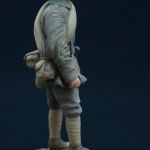
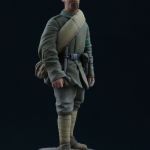
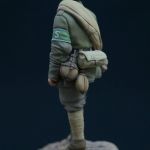
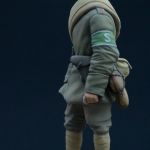
Stormtrooper, Saxon Divisional Assault Company, Western Front 1917
- Scale / Maßstab: 1/32nd (54mm)
- Material: Resin
- Parts / Teile: 10
- Infosheet / Infoblatt: English
- Code / Artikel-Nr.: 24LS
- Attention: Not a toy. Model kit or model making accessories – not suitable for children under 14 years of age. / Achtung: Kein Spielzeug. Modellbauzubehör – nicht für Kinder unter 14 Jahren geeignet
GPSR Data / Angaben
- Manufacturer / Hersteller: Jon Smith Modellbau
- Responsible Person / Verantwortliche Person
- Address: Hannoverstr. 68, 29664 Walsrode, Germany
- Contact / Kontakt: info@jonsmith-modellbau.com
- Tel: +49 (0)5161 8255
Contents / Inhalt:
- Figure (2 parts) / (2 Teile)
- 1st Head with Steel Helmet M.16 / 1. Kopf mit Stahlhelm M.16
- Alternative Head with Field Cap / Alternativ-Kopf mit Feldmütze
- Luger P08 / Pistole 08
- Tent Cloth M1892 / Zeltbahn M1892
- Gas Mask Bag / Segeltuchtasche für Gasmaske
- Water Bottle M07 / Feldflasche M1907
- Labe Water Bottle M15 / Labeflasche mit Trinkbecher M1915
- Trench Knife / Grabendolch
- M15 Stick Grenade / M15 Stielhandgranate
- Figure Base / Figur-Sockel


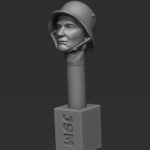

Above is the new 3D head now supplied with this kit.
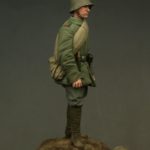
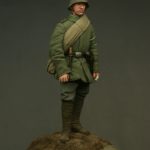
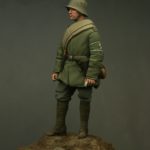
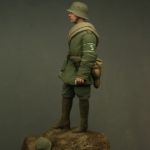
Above are photos of this figure painted by German figure painter Günter Sternberg. He has used one of the single spare German Steel Helmet heads (in this case SH44).
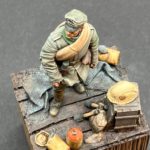
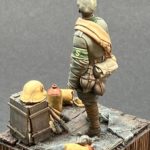
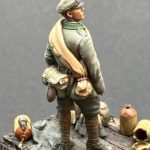

Above are photos from German figure painter Maks Hof of the Saxon Stormtrooper. He has used many other JSM spare parts and accessories for this figure incl. the 1/32nd scale Officer / NCO Field Cap Head, SRD Rum Jars and Covered German M16 Helmet.
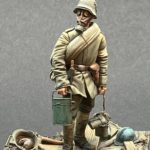
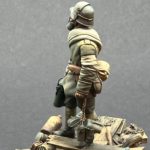

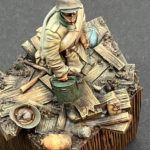
Another set of photos from Maks Hof, this time showing a different version of the Saxon Stormtrooper, with again other JSM spares, incl. the M16 Steel Helmet with Armoured Plate and Gas Mask M17, Trench Rat in Steel Helmet and holding the French Group Canteen Bouteillon.
The Figure: German Stormtrooper
The figure depicts a Stormtrooper taken from a group photo of 8 soldiers standing around an NCO/officer. The men are all armed with trench knifes and P08 Luger pistols (apart from one soldier who carries the Mauser C96 pistol). The left hand thumb of this soldier appears to be cleanly bandaged indicating an after-combat photo.
The first Sturmtrupp units appeared in mid-1915, arising from a re-think of tactics stemming out of the disastrous casualties caused by attacking enemy positions in extended lines during the first months of the war. Trained to fight in small flexible, non-linear groups at company, platoon and section level, using natural ground cover, instead of the traditional long skirmish lines. The tactics / fighting methods were constantly being reviewed and these units would engage the enemy with a variety of different weapons (grenades, flame throwers, semi-automatic pistols, captured Lewis machine guns, light trench mortars and man hauled infantry field guns).
The German Soldier of 1917 and 1918: The German soldier in 1917/18 had changed somewhat from his comrades of 1914. Firstly, he would have been much younger – on average about 18/19 years of age after finishing training – NCOs a year or two older. The style of his uniform differed not only in quality but function as well, with many items of clothing and equipment produced in Ersatz material. Infantry companies within the front line area numbered on averaged 75 – 80 soldiers, some as low as 50 (full company strength would be around 135 men), with the bulk of its fighting capacity and experience held by only 15 – 20 old sweats / NCOs. As the war progressed more emphasis was put onto automatic weapons and as many as 4 MG 08/15s per Infantry Company were to be found.
Head 1: This is the head from the photo and appears to be of a soldier of around 19 or 20 years. The helmet is tilted slightly to one side and pushed back towards the rear (no doubt for the photo).
Note: Between the chin straps and face there are thin in-fills to allow for a better casting function – these can be removed with a thin, sharp blade, or alternately painted in a dark shadow. On my painted example I removed the in-fills using a light-handled modelling knife with a new blade – it is not an easy exercise but will give the characteristic appearance of the M16 helmet with the wide-spaced chin strap fasteners on outer rim.
Head 2: This second head with this figure has more of the tradition look of an older soldier, with the typical fashionable half beard of the time. He wears the Feldmütze M1910. Made out of a field grey material. The band and piping were in red of the infantry. The two metal Kokarden badges at the front are – top: nation colours Die Reichsfarben: black, white and red (from outwards to the centre) and – bottom: represents the German State were the unit was raised – e.g. Prussia – Preussen: black, white and black. Bavaria – Bayern: white, light blue and white etc. See table below.
Uniform
Field Service Dress / Feldbluse M1915: Was to replace the early M1907/10 and the simplified M1914 service dress tunics. All three were in fact worn alongside each other throughout the war. Colour: made out of a dark-grey material (Jäger and Schützen units wore sometimes a green-grey version), with generally a baggy appearance. The turn down collar was green and the infantry had the shoulder straps outlined in white, with the regimental number, or monogram in red. Some units removed the shoulder straps altogether, particularly towards the end of the war. The six front buttons were hidden behind a flap and quite often Stormtrupp troops had leather patches on the elbows.
On the upper left arm is the green brassard with a white S, designating him as a member of a Saxon Divisional Assault Company. The brassard came about due to the fact that Saxon Assault Units were not officially given the elite Stormtrooper status and thus not recognised as such.
Note: Between the left arm and body there is a thin in-fill to allow for a better casting function – this can be removed with a thin, sharp blade.
Neck Cloth: The neck cloth can just be seen above the tunic collar. First issued in 1907 and was made out of a square piece of cotton material, rolled up several times like a scout’s neckerchief. Colour: grey.
Service Dress Trousers / Uniformhose M1914: Were identical to the M1907/10, but made out of a stone- grey material, quite often produced without the red stripe – Litzen – running down each side of the trouser leg (these were in the later war years left out). Colour: stone-grey.
Belt M1895 / Koppel M1895: From 1915 onwards, belts were issued blackened. The buckle was painted grey.
Puttees / Wickelgamaschen: Made out of any material available. Designed to cover the cap between boot and trousers, also keeping the lower leg warm and dry.
Boots M1901 / Knöchelhohe Stiefel M1901: Nailed ankle boots with between 35 and 45 nails in the sole and a reinforced heel. Colour: brown.
Equipment
Steel Helmet M16 / Stahlhelm M.16: This helmet, which first entered service in 1916 during the initial stages of the battle of Verdun was designed by Professor Friedrich Schwerd and made from a high quality chrome-nickel steel. Weighing between 950 and 1200g, depending on size – more heavier than the Allied helmets, but giving a better protection to the face, ears and neck. The horn venting bolts on each side enabled the fitting of an extra armoured shield over the helmet (also available in 1:32nd & 1:16th scales from Jon Smith Modellbau) for sentries, MG troops, snipers or other particularly exposed / dangerous employment. This weighing around 2000g was seldom used; although a total of 50000 were supposedly produced.
Colour: issued in field-grey, which would reflect in sun light and proved unsatisfactory. Various trials were carried out, but it was not until July 1918 that an official camouflage scheme in brown and green sharp-edged irregular patens, all outlined in black was introduced. These were carried out by unit maintenance workshops (other weapons and equipment, particularly artillery pieces and MGs were also rendered in the same way). It seems that helmets were re-painted by individuals or units in a variety of colour schemes before the official order and items with red-brown, ochre (brownish-yellow), green and blue-grey, all outlined in black were common. Helmets were also covered using the light-brown sandbag material, or the issued helmet-covers, seen particularly in the later war period.
The M.17 & 18 helmets followed with only slight differences to the inside padding and chin strap fasteners. The last model to see service during the war, if only in small numbers was the M.18 Ohrenausschnitt, or Helmet M.18 with ear cut-outs (also available in 1:32nd & 1:16th scales from JSM), more commonly (and stubbornly) known as the Cavalry or Telegraph Helmet. The cut-outs were in fact a further design feature of the M.18 to improve the hearing ability of the wearer and avoid the hissing noise experienced by troops.
Water Bottle M1907 / Feldflasche M1907: This had a capacity of 0.8 litres and was attached to the haversack or equipment belt by means of a leather strap and buckle. Originally made from aluminium, later Ersatz material and covered with a brown felt material. On one side are the four metal snap fasteners, which were normally painted over in grey. It was quite common for front line troops, particularly during combat periods to carry a second water bottle.
Labe Water Bottle M1915 / Labeflasche mit Trinkbecher M1915: Quite often called the Sanitäter or medical canteen and had a larger capacity of 1.2 litres. The canteen-drinking cup was originally made from aluminum and later in tinned steel, which sat on top of the bottle covering the cork plug. The light brown-grey felt covering is reinforced around the neck and rear. The natural coloured leather-carrying device enabled the canteen to be hooked to equipment or with an added harness hung over the shoulder. From November 1917 the leather straps were replaced by Papierstoff (a cloth substitute made of compressed paper-like fibers).
Canvas Gas Mask Holder / Segeltuchtasche für Gasmaske: In 1915 a canvas gas mask holder was issued with 2 dividing sections within, which stowed the mask, filter and reserve-filter in a metal tin. The holder was generally worn either attached to the belt below the rucksack at the rear, or on the right side/front by means of 2 belt loops, fastened with zinc buttons. Later versions of the holder had ring attachments on each of the belt loops enabling the fixing to the bread bag. Although, generally used in the early part of the war, late war photos still show troops issued with this holder. During combat the gas mask would of cause be more often worn at the front, sometimes even hung around the neck in the ready or alert position.
Tent Cloth M1892 / Zeltbahn M1892: Around the upper body the soldier wears a wrapped up M1892 tent section in the horseshoe-fashion. The two ends are held together with the leather greatcoat-fixing strap. Unlike the bulky greatcoats worn in the same fashion with other troops, these tent sections appeared quite flat on the upper bodies and would not have hindered the soldier. Amongst the normal use of making a quick shelter, these tent sections were quite often employed as substitute stretchers to evacuate causalities. Colour: Light brown-grey. (On original black & white photos they always appear to be a lot lighter against the field-grey tunics of the wearers).
Weapons
Pistol 08 / P 08: The 08 – or Luger (the Germans never called this weapon the Luger – this is an anglicised name) was first produced in 1900, with the German military taken it on in 1908 – hence P 08. As a service pistol it had its drawbacks, mainly it was expensive, difficult to produce and susceptible to dirt. Colour of holster: blackened leather.
Combat Dagger / Grabendolch: At first these unofficial weapons were purchased privately or made in unit metal smiths and workshops (first productions were in many cases shortened bayonets). The official order came in May 1915 from the Prussian War Ministry to issue 6 trench knifes per infantry unit. This was of cause inadequate and the amount was changed at first to 12 and later to 24 per unit. In March 1917 the official quantity was raised again to 40 per Company (Infantry, Engineer and Trench Mortar companies on the Western Front, 24 to units serving on the Eastern Front). Popular were knifes that could be attached to the end of rifles.
What seems strange is that there was never any standardisation put into effect by the War Ministries and many different designs of knives were purchased from civilian companies in Germany. Colour: On the photo the dagger appears to have wooden handle grips, the rest, including scabbard in metal.
Notes from the Sculptor
I chose to provide the figure with the Saxon armband, giving this soldier a speck of colour in an otherwise drab uniform. On the original photo most of the left arm is indeed hidden in shadow, showing only part of upper arm, hand and bandaged thumb. On the original photo there are no such armbands being worn. During the many years of interest and modelling World War I figures I have to date not come across any original photos of Saxon Assault Troops wearing this item – only a number of coloured plates in various books. Also, the added equipment at rear of figure is purely guesswork on my part, but based on other reference material. What seems unusual is the lack of any sign of stick grenades / carrying bags, which were often present on Stormtrooper group photos.
Stormtroops were if at all hard to distinguish from other soldiers, particularly in the later stage of the war. Assault troops were of cause issued newer equipment faster than the normal infantry units, but apart from the leather patches on some tunics and trousers and various small cloth badges (a grenade shaped badge was sometimes worn to distinguish them from other troops), no difference could be seen at a glance.
The weight of the pistol holster and water bottles at rear has pulled the belt downwards, giving a slightly off-balanced look. The wearing of the rolled up tent cloth, pushing the right arm outwards has also given this figure a slightly lopsided appearance.
I have added the correct German names of equipment / weapons etc. within this description. This will enable further reference research regarding painting if required on the many German collector / museum websites.
 An deutschsprachige Interessenten:
Sie können mich per eMail oder Telefon auch gerne auf deutsch kontaktieren. Ortsbesuch ist nach Absprache möglich.
An deutschsprachige Interessenten:
Sie können mich per eMail oder Telefon auch gerne auf deutsch kontaktieren. Ortsbesuch ist nach Absprache möglich.
